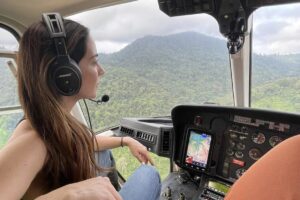
Award-winning reporter Mariana Atencio traveled to the Central American jungle retracing the steps of two Dutch tourists who disappeared in 2014. But for her, the story took an unexpected turn.
At the beginning of the year, I got a call about a story. It was about Kris Kremers, 21, and Lisanne Froon, 22, two Dutch women who went on a hike in Panama eight years ago and were never seen again. The Panamanian government had ruled their deaths an accident. The journalist on the other end of the line was Daily Beast reporter Jeremy Kryt, who had been following this case since the beginning. His question was matter-of-fact: Would I go to Panama with him to find out what really happened to the so-called “Lost Girls”?
The proposition reignited something in me that I hadn’t felt in a long time.
Two years after covering breaking news as a national correspondent for MSNBC, I decided to strike out as an entrepreneur during what turned out to be the Covid-19 downturn. I felt I was drifting. I grew my career as a social media influencer and it was feeding my income, but not my soul.
This story called me. There were elements about what supposedly happened to the women that didn’t add up. Kryt pointed to new evidence suggesting foul play: Kris and Lisanne may have been intercepted and assaulted on the hike.
Kryt didn’t know, but I had experienced something similar. More than 13 years ago, when I was nearly the same age as the Dutch women and a college student, I was hiking by myself in the Ávila mountains above my hometown of Caracas, Venezuela, and I was attacked by a man on a trail.
Fortunately, in my case, I did manage to survive the attack physically unharmed. But I have never forgotten the pain and the overwhelming feeling of helplessness it caused me. We keep trauma hidden away – lest it becomes too much to bear – but suddenly a stranger on the other end of the phone can unknowingly bring it forth in an instant, like a ton of bricks hitting you over the head on some idle Tuesday.
I realized I was a lost girl too. Here was a great chance to find myself by getting back to the work I loved the most, seeking the truth and long-delayed justice for these women and their families.
Many people – including my agent – told me not to take the job, and understandably so. Did it sound reasonable to just fly down to Central America and traipse around the jungle in a place where people might be covering up the deaths of these poor women? Still, there were so many elements about this mystery I couldn’t resist.




 But to get to the heart of this story, I had to get to the heart of the jungle. After flying down to Panama City, then west to a city called David and driving to Boquete, we started retracing Kris and Lisanne’s two-hour hike into “El Pianista” on the anniversary of their disappearance.
But to get to the heart of this story, I had to get to the heart of the jungle. After flying down to Panama City, then west to a city called David and driving to Boquete, we started retracing Kris and Lisanne’s two-hour hike into “El Pianista” on the anniversary of their disappearance.